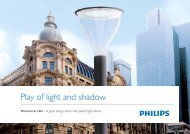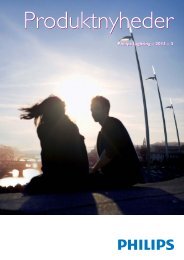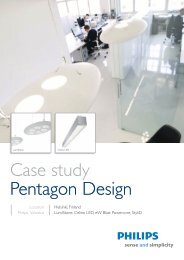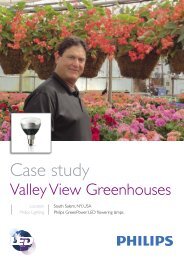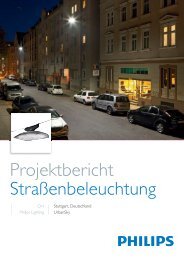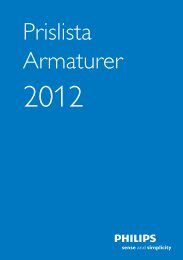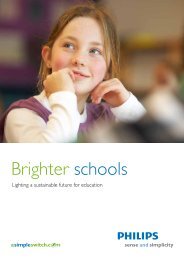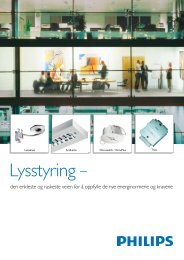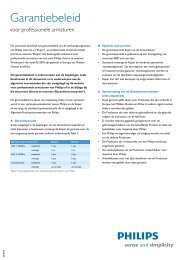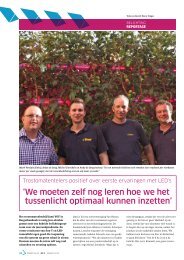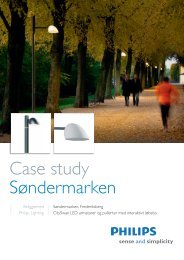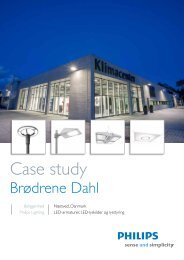Case study, In der Alten Forst, Hamburg, Germany - Philips
Case study, In der Alten Forst, Hamburg, Germany - Philips
Case study, In der Alten Forst, Hamburg, Germany - Philips
You also want an ePaper? Increase the reach of your titles
YUMPU automatically turns print PDFs into web optimized ePapers that Google loves.
©2010 Koninklijke <strong>Philips</strong> Electronics N.V.<br />
All rights reserved. Reproduction in whole or in part is prohibited without the prior written consent of the copyright owner.<br />
The information presented in this document does not form part of any quotation or contract, is believed to be accurate and<br />
reliable and may be changed without notice. No liability will be accepted by the publisher for any consequence of its use.<br />
Publication thereof does not convey nor imply any license un<strong>der</strong> patent- or other industrial or intellectual property rights.<br />
Date of release: May 2010 / UK<br />
Printed in the Netherlands<br />
<strong>Case</strong> <strong>study</strong><br />
<strong>In</strong> <strong>der</strong> <strong>Alten</strong> <strong>Forst</strong><br />
Location<br />
<strong>Philips</strong> Lighting<br />
<strong>Hamburg</strong>, <strong>Germany</strong><br />
SchoolVision Lighting solution
Background<br />
The primary school “Grundschule <strong>In</strong> <strong>der</strong> <strong>Alten</strong> <strong>Forst</strong>” is an innovative<br />
primary school in <strong>Hamburg</strong>, <strong>Germany</strong> with 12 classes and 368 children.<br />
The aim of School Director Andreas Wiedemann is for the school to<br />
become trusted for the optimised learning environment that it offers<br />
to children.<br />
Can light affect learning?<br />
We’ve known for a long time that light can affect our moods, making<br />
us feel less energetic on dull mornings than we do on bright, sunny<br />
days. Research into the highly complex relationship between light<br />
and well-being has led to some fascinating discoveries. Not only does<br />
exposure to higher levels of blue light in the daylight spectrum make<br />
us feel better; the receptors in the eye’s retina also help to produce<br />
the neurotransmitters that control our mood and activity, So what<br />
effect could light have on learning behaviour? To discover more a new<br />
<strong>study</strong> was conducted by Prof. Dr. Michael Schulte-Markwort, Director<br />
of the Clinic for Psychosomatics in Children and Juveniles at the<br />
University Medical Centre <strong>Hamburg</strong>-Eppendorf on behalf of <strong>Philips</strong>.<br />
The intention was to see whether light could be used to influence the<br />
learning behaviour of school children.<br />
About the <strong>study</strong><br />
A total of 166 schoolchildren aged between 8 and 16 took part in the<br />
year-long <strong>study</strong>, along with 18 teachers. The <strong>study</strong> covered a range of<br />
“ We saw for ourselves and the results confirmed that the<br />
specific application of light really can have a positive<br />
effect on learning and the learning environment.”<br />
Andreas Wiedemann, School Director, <strong>In</strong> <strong>der</strong> <strong>Alten</strong> <strong>Forst</strong><br />
Errors (overall)<br />
180%<br />
170%<br />
160%<br />
150%<br />
140%<br />
130%<br />
120%<br />
110%<br />
100%<br />
90%<br />
80%<br />
1100<br />
1075<br />
1050<br />
1025<br />
1000<br />
970<br />
950<br />
925<br />
900<br />
875<br />
850<br />
825<br />
800<br />
775<br />
750<br />
725<br />
700<br />
16.3<br />
1<br />
1<br />
Module<br />
Module<br />
2<br />
2<br />
9.0<br />
Errors relating to concentration -44.9%<br />
Number of words read<br />
780<br />
1051<br />
Reading performance +34.8% Restlessness -76.6%<br />
Source: “Wirksamkeit von dynamischen Licht in <strong>Hamburg</strong>er<br />
Schulklassen”, May 2009<br />
Universitätsklinikum <strong>Hamburg</strong>-Eppendorf, Klinik und Poliklinik für<br />
Kin<strong>der</strong>- und Jugendpsychosomatik, Michael Schulte-Marktwort,<br />
Claus Barkmann & Nino Wessolowski<br />
www.uke.de/kliniken/kin<strong>der</strong>spychosomatik/index_53560.php<br />
Optical measurement of motoral restlessness<br />
1800<br />
1600<br />
1400<br />
1200<br />
1000<br />
25 min 5 min<br />
Module<br />
75 min 10 min<br />
classes in different types of schools and naturally the School Director<br />
of the “Grundschule <strong>In</strong> <strong>der</strong> <strong>Alten</strong> <strong>Forst</strong>” was keen to take part. Prior<br />
to the <strong>study</strong>, the existing classroom lighting was replaced with the<br />
<strong>Philips</strong> SchoolVision solution with Dynamic Lighting to see what<br />
impact it had on the behaviour and performance of pupils.<br />
What is SchoolVision?<br />
SchoolVision is a classroom lighting solution that helps to improve<br />
learning conditions by bringing the dynamics of daylight into the<br />
classroom. The teacher can control the classroom atmosphere to<br />
create exactly the right atmosphere, tailoring the light to suit the<br />
learning task or the time of day. By making the learning environment<br />
as comfortable as possible for each activity, it keeps young minds alert<br />
and eager to take part, optimising results for teachers and pupils.<br />
How does SchoolVision work?<br />
Four dedicated lighting scenes are available for the teacher to select<br />
via a touchpad. The scenes are produced by varying the balance<br />
between light intensity and colour tone/temperature to create a<br />
particular ambience that is suitable for a certain tasks or the time<br />
of day. Normal is for regular classroom activities. Energy helps to<br />
invigorate pupils when the need to be more active, supporting a<br />
fresh start to the day (morning) or afternoon (after lunch break).<br />
Focus aids concentration during challenging tasks and Calm brings<br />
a relaxing ambience to individual work or quiet time.<br />
800<br />
600<br />
400<br />
200<br />
0<br />
1437<br />
712<br />
336<br />
445<br />
SchoolVision gives a lesson in<br />
learning to the primary school<br />
“<strong>In</strong> <strong>der</strong> <strong>Alten</strong> <strong>Forst</strong>”<br />
The results were clear<br />
Reading speed increased by almost 35% in the SchoolVision<br />
<strong>study</strong> and the concentration also improved dramatically and the<br />
frequency of errors dropping by almost 45%. Hyperactivity and<br />
aggression were also examined. Although the perceived reduction<br />
in aggression was not found to be significant, video evidence<br />
showed a distinct change in levels of hyperactivity. Observed<br />
hyperactivity was reduced by up to 76% when pupils were given<br />
a mathematical problem to solve un<strong>der</strong> the Calm lighting scene,<br />
a figure that the baseline measurement and control group did<br />
not even come close to.<br />
How were the results measured?<br />
Scientifically proven standard tests were used to measure levels of<br />
attention and concentration. These were D2 attention load tests and/<br />
or reading comprehension test, depending on the child’s age. The<br />
results with SchoolVision were compared with those of the baseline<br />
measurement. A control group working un<strong>der</strong> standard light was also<br />
used as a comparison.<br />
What can we learn?<br />
The <strong>study</strong> shows that attention span, concentration and behaviour<br />
is significantly improved through the use of dedicated light settings.<br />
SchoolVision provides teachers and schools with a new tool to<br />
improve performance and support the well-being of children at school.<br />
Fast Facts<br />
Client<br />
Grundschule <strong>In</strong> <strong>der</strong> <strong>Alten</strong> <strong>Forst</strong><br />
Project<br />
Classroom lighting<br />
Location<br />
<strong>Hamburg</strong>, <strong>Germany</strong><br />
Lighting<br />
<strong>Philips</strong> SchoolVision with Dynamic Lighting<br />
Project responsibility<br />
Client: Andreas Wiedemann, School Director <strong>In</strong> <strong>der</strong> <strong>Alten</strong><br />
<strong>Forst</strong>, <strong>Hamburg</strong><br />
<strong>Philips</strong>: Günter Hohensee, Gerd Wiesemann<br />
UKE: Prof. Dr. M. Schulte-Markwort, Dipl.-Psych. N.<br />
Wessolowski<br />
The conclusion can only be that children’s activity can be positively and<br />
significantly supported with the targeted use of the right kind of light.<br />
What is Dynamic Lighting?<br />
Most schools have standard lighting systems with a fixed colour<br />
temperature. Dynamic Lighting adjusts these values with seamless<br />
changes in lighting patterns that simulate natural daylight. The <strong>Philips</strong><br />
luminaires used in the <strong>study</strong> featured two unique ActiViva Active<br />
TL5 and a fluorescent TL5 lamp with a similar warm-white colour<br />
temperature to conventional bulbs. By mixing the light to vary the<br />
brightness and colour mood, Dynamic Lighting provided stimulation or<br />
relaxation, achieving the right psychological effect to benefit the task.<br />
Best learning environment<br />
By bringing the dynamics of daylight indoors, SchoolVision has created<br />
an outstanding learning environment that gives pupils at <strong>In</strong> <strong>der</strong> <strong>Alten</strong><br />
<strong>Forst</strong> the very best start in school. Daylight sensors also dim the lights<br />
when there is enough natural daylight and presence detectors turn the<br />
lights off when the classroom is empty, saving the school even more<br />
in energy costs.



